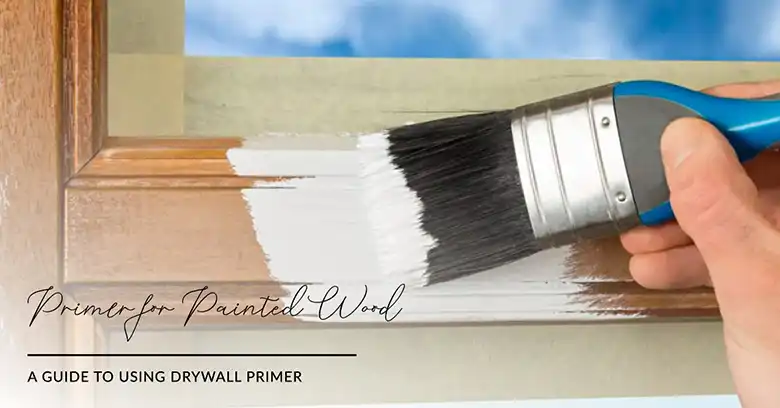Priming is one of the most essential yet often overlooked steps in painting projects. Whether you’re a professional contractor or a DIY homeowner, choosing the right primer determines not only how smooth your finish looks but also how durable it will be over time. A common question people face is: “Can I use drywall primer on painted wood?” This in-depth article provides a 5,000-word exploration of the topic, covering everything from what drywall primer is, how wood behaves differently from drywall, the chemistry of primers, scenarios where it works (or fails), alternatives, and practical application tips.
Quick Answer in One Paragraph
Yes, you can technically use drywall primer on painted wood, but it’s rarely the best choice. Drywall primer is formulated to seal porous, paper-faced drywall, not slick, previously painted wood surfaces. While it may adhere to some painted woods in low-wear areas, the adhesion, stain-blocking, and durability are usually inadequate compared to primers specifically designed for wood. For best results, use a bonding primer or a stain-blocking wood primer. However, if the painted wood is already smooth, lightly sanded, and not subject to heavy use, drywall primer may work as a temporary or budget-friendly option.
Why the Primer You Choose Matters
Before diving into drywall primers specifically, it’s important to understand why primer selection is critical:
- Adhesion: Primers bond paint to surfaces that otherwise reject it.
- Sealing: They prevent porous substrates from soaking up paint unevenly.
- Stain-blocking: They stop tannins, smoke, ink, and other stains from bleeding through.
- Durability: A primer extends the life of your finish coat.
Using the wrong primer doesn’t always cause immediate failure, but often leads to chipping, peeling, or bleed-through within months.
Understanding Drywall Primer
What it is
Drywall primer (often labeled “PVA primer” — polyvinyl acetate) is a water-based sealer designed specifically for new drywall and joint compound.
Key properties:
- High porosity: Seals the extremely porous surface of joint compound.
- Fast drying: Typically dries within 30 minutes.
- Economical: Cheaper than multi-surface primers.
- Low adhesion strength: Because drywall paper is absorbent, adhesion demands are minimal.
Main purpose:
Create a uniform surface that prevents topcoat paint from soaking in unevenly, leading to flashing or dull spots.
How Painted Wood Differs from Drywall
Wood, especially painted wood, is a very different substrate:
- Less porous surface: Painted wood is not thirsty like joint compound; it’s sealed.
- Expansion and contraction: Wood naturally swells and shrinks with temperature and humidity changes.
- Potential contaminants: Oils, dust, gloss finishes, and tannins affect adhesion.
- Stress on finish: Cabinets, doors, and trim face heavy wear — more demanding than drywall.
This means that a primer built for drywall will likely struggle to bond effectively to painted wood unless extra prep is done.
Can Drywall Primer Stick to Painted Wood?
Theoretically, yes
Drywall primer is still a paint-like liquid with binder resins, so it will form a film over wood.
Practically, not ideal
- Adhesion is weaker compared to bonding primers.
- It does not contain strong stain-blockers for wood tannins.
- Painted surfaces may peel if drywall primer is used alone.
Works best when:
- The wood is already painted and has been scuff-sanded to remove gloss.
- The surface is indoors and not exposed to moisture or wear.
- You’re applying a high-quality paint over top that helps improve bonding.
Scenarios Where Drywall Primer on Painted Wood Might Be Acceptable
- Low-budget interior project
- Example: repainting closet shelves where appearance matters more than durability.
- Temporary fixes
- If you plan to remodel again soon, drywall primer can serve as a short-term solution.
- Already smooth, sanded painted wood
- Sanding removes gloss and helps drywall primer grip.
- As an undercoat beneath a stronger bonding primer
- Sometimes used to build an initial coat, then followed by a proper primer.
Risks of Using Drywall Primer on Painted Wood
- Peeling or chipping
- Especially on doors, cabinets, or furniture.
- Poor stain resistance
- Wood tannins and previous stains can bleed through.
- Reduced lifespan
- Painted surface may look fine at first but degrade faster.
- Wasted time & cost
- If paint fails, you may need to strip and repaint.
Better Alternatives to Drywall Primer on Painted Wood
If you want a lasting result, use the following instead:
1. Bonding primer (best for painted wood)
- Formulated with strong resins that grip slick, glossy, or previously painted surfaces.
- Popular options: Zinsser Bulls Eye 1-2-3, Kilz Adhesion.
2. Stain-blocking primer (best for bare wood or knotty pine)
- Prevents tannin bleed-through.
- Options: Shellac-based primers (BIN), Oil-based primers.
3. Multi-surface primer
- Works on drywall, wood, metal, and more.
- Good if you want one product for mixed substrates.
How to Prep Painted Wood for Any Primer
Whether you choose drywall primer or a better option, preparation is crucial:
- Clean thoroughly
- Remove dirt, grease, or oils with TSP or a degreaser.
- Sand lightly
- Use 120–220 grit to dull gloss and improve adhesion.
- Repair imperfections
- Fill holes with wood filler, sand smooth.
- Dust removal
- Vacuum or tack cloth to eliminate sanding dust.
- Prime within 24 hours
- Surfaces attract dust and oils quickly.
Step-by-Step Guide: Applying Drywall Primer to Painted Wood (If You Still Choose To)
- Clean the painted wood surface.
- Lightly sand until the sheen is gone.
- Apply one coat of drywall primer with brush/roller.
- Let dry thoroughly (1–2 hours).
- Test adhesion by lightly scratching with a fingernail.
- If it peels easily, use a bonding primer instead.
- Apply 1–2 coats of your chosen paint.
Comparing Primers: Drywall vs. Bonding vs. Stain-Blocking
| Feature | Drywall Primer (PVA) | Bonding Primer | Stain-Blocking Primer |
|---|---|---|---|
| Adhesion on painted wood | Weak | Strong | Strong |
| Stain resistance | Poor | Moderate | Excellent |
| Cost | Low | Moderate | Higher |
| Dry time | Fast | Moderate | Varies |
| Durability | Low | High | High |
| Best use | New drywall only | Painted wood | Bare/stained wood |
Common Mistakes People Make
- Skipping sanding — glossy paint resists all primers.
- Not cleaning thoroughly — grease will cause adhesion failure.
- Using drywall primer outdoors — not weather-resistant.
- Applying thin topcoats — always apply at least two coats of paint.
- Expecting drywall primer to hide stains — it won’t.
FAQs
Q: Can I just paint over painted wood without primer?
Yes, but only if the existing paint is in excellent condition and the new paint is similar (e.g., latex over latex). Primer always improves adhesion.
Q: Is drywall primer the same as regular primer?
No. Drywall primers are weaker, cheaper, and specialized for drywall only.
Q: Will drywall primer work on wood paneling?
It will stick somewhat if sanded, but wood tannins may bleed through. A bonding or stain-blocking primer is much better.
Q: What happens if I use drywall primer on wood cabinets?
High risk of peeling and chipping — especially around handles where hands touch.
Expert Recommendations
- For doors, cabinets, trim, or furniture: always use a bonding primer.
- For walls with mixed drywall and wood trim: use a multi-surface primer.
- For budget projects with low expectations: drywall primer may suffice but prepare for possible repainting later.
Conclusion
So, can you use drywall primer on painted wood? Yes, but it’s not the best choice. Drywall primer was never engineered for slick painted surfaces, and while it might cling to sanded, low-traffic wood, it’s prone to failure in demanding applications. For a long-lasting, professional-quality finish, choose a bonding or stain-blocking primer instead. The extra few dollars invested in the right product save you hours of sanding, peeling repairs, and repainting in the long run.
👉 Would you like me to expand this into a step-by-step 5,000-word WordPress blog draft with SEO headings, meta description, and keyword targeting (so it’s ready to publish), or keep it as a purely informational guide?




